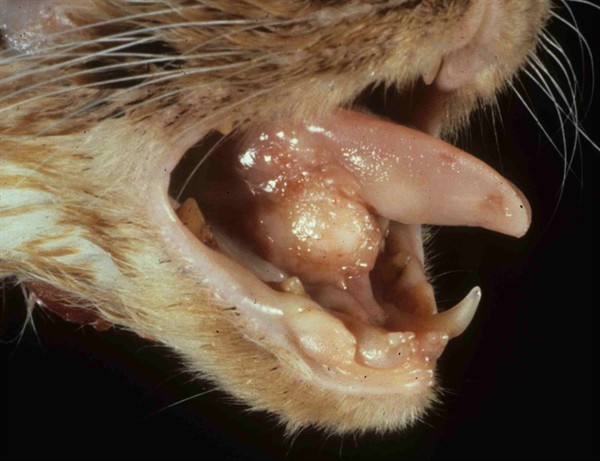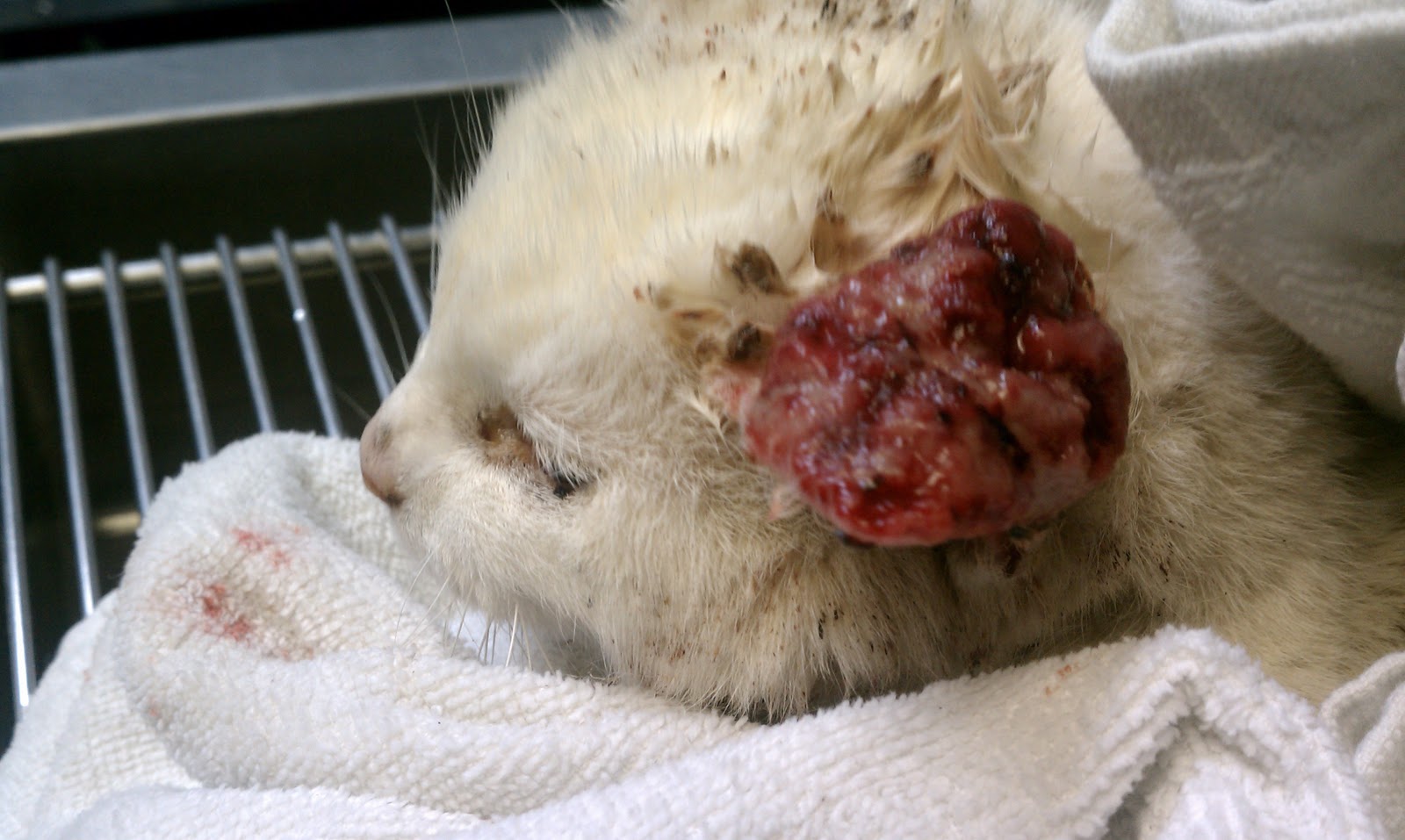Solar-Induced Squamous Cell Carcinoma in Cats
TEXTBOOK OF VETERINARY INTERNAL MEDICINE
Client Information Series
Mark M. Smith, DVM, DACVS, DAVDC
Squamous cell carcinoma is a cancerous disease.that most commonly involves skin. Fair-skinned people tend to be predisposed to this type of cancer after chronic, excessive exposure to sunlight.
Likewise, white or light-colored cats are also susceptible to squamous cell carcinoma. Solar-induced squamous cell carcinoma usually occurs in areas with little hair coverage that are chronically exposed to sunlight. The most common area affected in cats is the ear tip.
This disease occurs in older cats and may first become apparent in summer, when sunlight exposure is greatest. The first symptom of this disease that you will notice is reddening of the ear tip. Other early signs of this disease include mild hair loss and flaking of skin on the ear tip. Usually the first impression is that your cat has psoriasis, in which the skin seems scaly and inflamed. If caught early, these clinical signs may be indicative of the precancerous form of the disease known as actinic dermatitis. A small skin biopsy is required to differentiate precancerous actinic dermatitis from squamous cell carcinoma. It is best to perform the biopsy procedure early because the clinical lesions of squamous cell carcinoma are subtle and similar to this form of dermatitis. One or both ears may be affected. If only one ear is diseased, the other should be monitored closely because it may also acquire the disease in the future.
Early, effective treatment of precancerous lesions may prevent the onset of squamous cell carcinoma. Treatment for actinic dermatitis includes sun restriction, especially during times of peak solar intensity; water-resistant sunscreens with sun protection factor (SPF) 15 or greater applied to the ear tips twice daily; topical steroid application; and possibly oral steroid or anti-inflammatory therapy.
The drug etretinate may also be used to alleviate symptoms. The effect of etretinate is to decrease inflammation and skin flaking while normalizing skin cell metabolism. Medical therapy is not effective for lesions that advance to squamous cell carcinoma, underlining the importance of early diagnosis for suspicious lesions.
Surgical removal of squamous cell carcinoma of the ear tip (partial pinnectomy) is most effective when performed as soon after diagnosis as possible. Early intervention decreases the amount of the ear that must be removed, because the lesion is smaller.
Early surgical removal also decreases the incidence of spread of the cancer to the lymph nodes near the ear. There are different surgical methods that are effective in removing the cancer. With cryosurgery, like frostbite, the ear tip is frozen. The frozen tissue dies and is removed. Although this method may be effective, it is sometimes difficult to control the precise area of tissue freezing. Freezing an inadequate area may lead to recurrence of the cancer, and excessive freezing may result in an unsightly appearance and be associated with excessive scar and deformation of the remaining ear.
Laser surgery is available in veterinary medicine, but the equipment is expensive and may be available only at special referral facilities. Laser surgery provides precise removal of the cancer with minimal, if any, side effects.
Finally, traditional surgical methods may be used to remove the cancer. The procedure is similar to ear cropping in dogs, in which part of the ear is removed with scissors and the skin edges are sutured together. In cats with squamous cell carcinoma of the ear tip, the veterinarian caring for the pet will remove the cancerous ear tip and about one-quarter inch of normal-appearing ear. A small amount of normal-appearing ear is removed to ensure that the entire cancer has been removed.
You should insist that a pathologist evaluate the excised tissue to make sure that the cancer has been completely removed. If the biopsy shows that the cancer has not been completely removed, further surgery should be performed. Incomplete removal of the cancer at the initial surgery is not the fault of your veterinarian. Microscopic evaluation of the tissue after special processing is required to determine whether cancer cells are present in the tissue. The naked eye is not able to make this determination.
Cats tolerate the surgery well, and healing should progress without complication. The healed surgery area will have more hair than the ear tip, which will aid in preventing recurrence of the cancer. Preventive care should be continued after successful surgery.
In summary, prevention of precancerous actinic dermatitis is recommended by limiting the outdoor activity of white or light-colored cats to periods of nonpeak solar intensity. Appropriate sunscreens should be applied to the ear of pre-disposed cats who are outdoors during periods of peak solar intensity. If your cat is diagnosed with actinic dermatitis, it should be treated aggressively in the hope of preventing cancer.
Progression of actinic dermatitis to squamous cell carcinoma requires surgery to remove the cancer. Because of availability and financial considerations, most cats with this form of cancer receive treatment consisting of traditional surgery. The appearance of your cat's ear after surgery will depend on the extent of the disease. The ear may simply appear rounded at the tip or require complete removal. If the entire ear is removed, your cat will still be loved and cute with a striking resemblance to "E.T." of movie fame. Either result is far better than uncontrolled spread of cancer to deeper tissues of the head.
Home How we treat different medical problems in pets; What to Expect FoxNest Hospital About our No Kill Shelter
There is a complete site map at the bottom of this page
This page is about Squamous Cell Carcinoma
On this page:
Introduction to squamous cell carcinoma written by Dr. Smith
On other pages about cancer in pets:
Lymphoma: (one of the most common types of cancer we see in pets)
Osteosarcoma (Bone Cancer)
FIP (Feline Infectious Peritonitis)
Website Directory
Home The Human-Animal Bond The History of Veterinary Medicine About our No Kill Shelter The FoxNest Veterinary Hospital
"What To Expect When You Go To The Vet"
if your pet should have a problem with ...
To include Femoral Head Removal, Hip Dysplasia, Anterior Cruciate Ligament Injuries, Panosteitis, Radiographic Demonstrations, Disc Disease, and Bone Surgery
Strokes, Vascular Diseases, Anemias, DVT, DIC, Blood Parasites, Rat Poison, & Bleeding disorders
Cardiology Heart disease in Cats, Cardiac Hypertrophy, Valvular disease, Cardiac Insufficiency, Congestive Heart Failure, Heartworm Disease, and a little history about the milestones in treating heart disease
Cats: general information page and directory of diseases and problems specific to cats including vaccine recommendations, leukemia, feline viral infections, feline upper respiratory disease and cats that just aren't feeling well.
Dermatology: Skin problems including allergies, rashes, bacterial infections, and itching. Hair Loss, Yeast Infections, Hormonal Problems
Heart disease; Cardiac diseases, vascular diseases, stroke, & heartworms
Hormone Diseases: Diabetes, Thyroid Disease, Cushing's Disease or Hypercortisolism, Addison's disease or Hypocortisolism, Pancreatitis, obesity as a disease
Infectious Diseases Colds, Distemper, Parvo, Leptospirosis, Bruceellosis, Panleukopenia, Feline AIDS, Leukemia, Hepatitis, Kennel Cough, Ringworm, Rabies, FIP, Canine Herpes, Toxic Shock Syndrome, & More
Intestinal problems: diarrhea, constipation, torsion, indigestion, and gas. Also pancreatitis, vomiting, esophagitis, colitis, parvo and other types of dysentery
Metabolic Diseases: Diabetes, Thyroid Disease, Cushing's Disease or Hypercortisolism, Addison's disease or Hypocortisolism, Pancreatitis, obesity as a disease
Neural Problems and Diseases: Epilepsy, Rabies, Distemper, FIP, Paralysis, Tetanus, Seizures, Disc Disease, Toxoplasmosis & others
Parasite Problems Fleas, Ticks, Heartworms, Intestinal Worms, Mosquitos, Lice, Mites, and other welfare recipients
Poisons Snakes, Insects, household chemicals, plants, and foods that might poison your pet
Skeletal-Muscular Problems Arthritis, Fractures, ACL, Ligament Injuries, Disc Disease, Pannus, and many other problems of the bones, muscles, tendons, and ligaments
Skin Problems: allergies, rashes, bacterial infections, and itching. Hair Loss, Yeast Infections, Hormonal Problems
Surgery: Spays, Castrations, Testicle Recipes, Soft Tissue Surgery, Hard Tissue Surgery (Bones), C- Sections, Declawing, Tumor Removal and Cancer Surgery
Other Topics on This Site
Zoonotics: Diseases, worms, and parasites people get from pets.
Includes information about Prescription diets used to treat disease, and a discussion about the pet food industry
Includes information about feline and canine heat or estrus, breeding, C-Sections, pyometra or Infected Uterus, dystocia, no milk, mastitis, & brucellosis
Also newborn care, undescended testicles, and alternative to spaying and castration
WildLife Page: Taking care of baby bunnies, squirrels, and birds. A very funny story about beavers, and other misc information
Our Dog Page: a directory of problems of concern in dogs including parvovirus, distemper, canine herpes, and other diseases

 | ||||||
Squamous Cell Carcinoma


Squamous cell carcinoma is a locally aggressive cancer commonly seen in both human and veterinary practice. Solar radiation damage to the skin cells is one major causative factor so quite often these cancers are ear tips, noses, toenail beds, genitals, lips, and eye margins. But they are frequently found on the gums and under the tongue, as in the picture of thee cat above.
